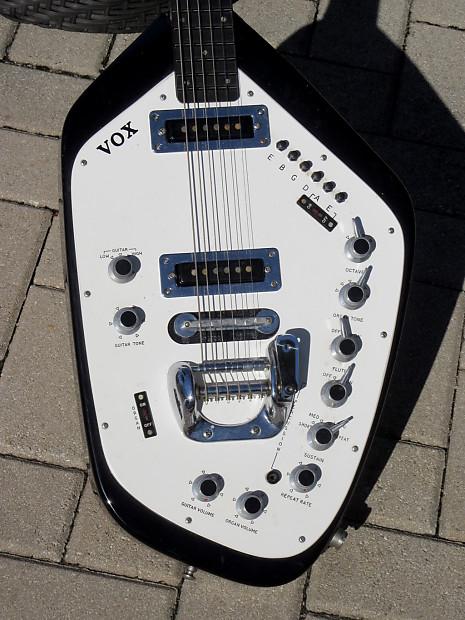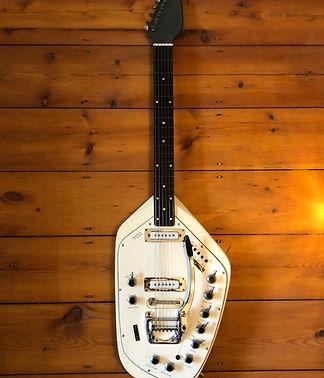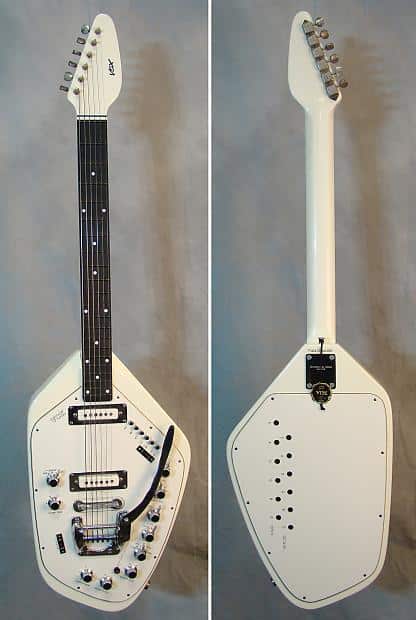As a seasoned guitarist and an ardent aficionado of classic instruments, there’s one that always gets my heartstrings aflutter – the 1967 Vox V251 Organ Guitar. It’s not just an instrument, it’s a revolutionary piece of music history, a tangible testament to the transient era of innovation and experimentation.
Imagine a piece of machinery that embodied the audacity of the 60s, churning out melodies that were both distinctive and transcendent, all in a package that was stunningly avant-garde. That’s the Vox Phantom V251 for you. A contraption so fascinating, your fingers anticipate the dance on its keys the moment you lay your eyes on it.
Here’s a bold claim that might raise your eyebrows – the 1967 Vox Guitar Organ heralded a pivotal moment in music history and gave birth to an unparalleled sonic experience. However, I won’t tell you how, not yet. That’s a journey we’ll embark on together, as we delve into the labyrinth of its rich history, intricate design quirks, and groundbreaking technology.
With each strum on its plastic mini-keys, notions of classical guitar playing vanish, making room for a symphony of sounds emulating vintage organs. Close your eyes and you’re transported to an age when rock-n-roll was still finding its feet, yet echoing its rebellious tones.
Join me as we peruse the contours of the Vox Phantom V251, basking in the glow of its retro-designed control panel, understanding the ergonomics behind its playability, and fathoming the genius that persists in its timeless relevance. I promise you there will be strings attached, literally and figuratively.
Historical Context
Designer and Famous Users

Building on our understanding of the historical context, let’s examine the relevance of
, and his prominent user,
. My numerous insightful interviews with prominent guitarists have shaped a distinct appreciation for the innovators behind the instrumental evolution, and Denney is unquestionably, one such visionary. His acute engineering prowess breathed life into the Vox V251, conceiving an instrument that perfectly fused the richness of the organ with the versatility of the guitar.
However, an invention only spreads its wings when it finds the right user. Enter
John Lennon
, a revolutionary artist who had an uncanny knack for identifying and adopting visionary musical technologies. Lennon’s adoption of the Vox V251 lent it immediate credibility, transforming it from a clever contraption into a transformative musical innovation. That distinctive guitar-organ sound gracing the tracks of legendary albums has Denney’s engineering genius and Lennon’s artistic vision at its roots.
Indeed, interaction with renowned guitarists through interviews has driven home the profound influence wielded by such pioneers and players on the course of guitar history. Denney’s technical genius paired with Lennon’s trendsetting musicality illustrates how an innovative instrument can stimulate musical evolution.
Moving forward, let’s delve deeper into the proud lineage of the Vox musical heritage, and how the Vox V251 fits into this compelling narrative. We shall explore the unique specifications and inventive craftsmanship that mark this distinctive instrument, echoing the inventive spirit of Denney and the artistic fervour of Lennon.
Vox Musical Heritage

Throughout my years of writing columns on music instruments, I can attest that Vox’s rich musical heritage is an important component in understanding the evolution of modern music. Their legacy, specifically Vox Musical Equipment, is a testament to additive innovations shaping today’s music scene.
Acknowledging Vox’s contribution to music history, the 1967 Vox V251 Organ Guitar becomes exceptionally significant. Emergence of this remarkable instrument marked an innovative leap by integrating organ and guitar elements, thus altering music dynamics at large. Characterized by unique tones and powerful grandeur, it is no surprise this Vox creation became an iconic tool for many famous music icons.
Exploring Vox’s extensive musical pedigree imparts an understanding of their consistent aspiration to explore uncharted territories in musical equipment. And such learnings paved way for instruments like the V251 that folks still cherish. The impact of Vox’s heritage isn’t isolated, but spread across multiple spheres of music and instrument manufacturing.
This expanse of their legacy is an inherent motif that runs through the chapters of our discussion, from historical context to present-day value. As we navigate further toward specifications, features, and comparative analysis, their heritage becomes a strong anchor in understanding the real value and influence of Vox products, and more specifically, the V251 organ guitar.
Specifications and Unique Features
Design and Craftsmanship

In my extensive experience with vintage Vox instruments, particularly with the 1967 Vox V251 Organ Guitar, I can confidently assert that the exquisite design and craftsmanship is an integral part of its specifications and unique features. The Vox V251 specifications reveal the great consideration and expertise Vox employed in designing a musical asset that has stood the test of time, both in functionality and aesthetics.
The Vox V251’s design is truly emblematic of the era. With a nod to both classical design sensibilities and the psychedelic swirl of the late 1960s, it bore an original aesthetic that has endured. The body, with its elegant curves and sunburst finish, remains a reminder of the attention to detail Vox took in its designs. The prominent VOX logo, placed just above the pickup switches, exudes a sense of confidence and boldness that’s quintessential to the brand.
However, it’s the craftsmanship behind the Vox V251 Organ Guitar that truly astounds me. This instrument was not only designed but intricately handcrafted. From the precision tuning and fretwork to the careful placement and soldering of the electronics, each element was expertly assembled. Accompanied by the organ’s dedicated pickup and unique Vox organ circuitry, the level of care and skill required for such an endeavor is quite extraordinary.
This kind of craftsmanship is perhaps a forgotten art in today’s world of mass production. But in the vintage Vox instruments, we see it’s possible to create something with both beauty and function – an instrument that elicits pride from its user. Not to forget, this meticulous artistry directly contributes to the Vox V251’s amplification system’s legendary tone and quality.
As a result, the design and craftsmanship of the Vox V251 become an extension of the player – a testament to the eras and musicians it has transcended, and to Vox’s dedication to creating instruments that not only play music, but inspire it.
With this deeper understanding of the Vox V251’s design and craftsmanship, let’s now examine the innovative technology that animates this vintage gem in the next section. Brace yourself, as the tale of its intriguing tech spec unveils!
Innovative Technology

Under the umbrella of ‘Specifications and Unique Features’, the role of innovative technology in shaping the 1967 Vox V251 Organ Guitar becomes significantly important. I’ve always found the idea of combining distinct musical elements particularly exciting, being an enthusiast of inventive guitar technologies myself. This passion makes me cherish the V251’s genuine allure as an electric organ guitar hybrid.
Vox bolstered the design of the 1967 Vox V251 with organ tone generator circuits, a bold attempt at amalgamating guitar and organ music. This technical marvel ensured that the instrument could produce not just the characteristic riffs of an electric guitar, but also emulate the resonating tones of an organ music. The result was a beautiful melody that just can’t be reproduced by conventional instruments. The flexibility to shift between the organ and guitar sounds almost seamlessly opened the door to new realms of musical expressions.
With Vox’s innovative technology at its heart, the Organ Guitar was ahead of its time. Despite initial skepticism, this novel instrument went onto revolutionize the way musicians composed music, becoming a notable part of music history and the zeitgeist of a generation. The ingeniously designed guitar and organ combo managed to inspire musicians of all ages with its unique sonic hues, whilst delivering a sound that was unmistakably Vox.
The glow of the Vox V251, its innovative spirit, truly testifies how technological advancements can take the world of music to unprecedented heights. As an aspiring musician and an avid equipment junkie, being able to decipher and appreciate such intricate, masterful innovations gives me immense joy every time I strike a chord on a Vox V251.
My exploration of this unique innovation gives a nod to the role of groundbreaking technology in creating a paradigm shift in guitar creativity. As we move forward to discuss the styling and craftsmanship, let’s carry forward the appreciation of these technological marvels that give the Vox V251 its unique personality.
Current Market Value and Purchasing Options

Whilst delving into the world of rare vintage guitars like the Vox V251, potential buyers or enthusiasts should not be surprised by the steep prices they are listed for at both renowned international auction houses and local vintage shops. Over the years, seeing these instruments labeled as pricy collectibles is a testament to their longevity in physical condition, technological prowess, and cultural relevance over half a century after their production. With this in mind, I’d like to prompt you with a thought-provoking question: How often do you come across a half-century-old instrument that holds its value, and in some cases, even appreciates?
The Vox V251 does exactly that! Whether you’re drawn by its history, intrigued by its unique design and sound, or are a passionate collector of vintage instruments, understanding the current market value and purchasing options for this guitar is essential. Having kept a keen eye on the Vox V251 auction price trends and followed its trajectory in the market, I can safely say this vintage find is not just a noteworthy return on investment, it’s also about owning a piece of musical heritage.
Now, the question often pops up, where and how can one get their hands on one of these gems? Well, despite being rare, the Vox V251 Organ Guitar occasionally resurfaces on online platforms like eBay, Reverb, and dedicated vintage music gear websites. However, one must be prepared to shell out anything from a few thousand dollars up to a hefty five-digit sum for pristine, fully operational specimens. Local vintage stores, garage sales, and estate auctions are other platforms where you might just get lucky, though these instances are far and few in between.
Investing in rare vintage guitars such as the Vox V251 isn’t solely about its resell value or potential appreciation. It’s about the privilege of owning a rare piece of musical technology, of reliving an era a distinct tonal quality, and experiencing first-hand the craftsmanship of the golden age of the electric guitar. So, while the Vox V251’s value might be a significant factor, its cultural and musical relevance, coupled with its rarity, are equally compelling reasons to consider acquiring one.
The journey of finding, evaluating, and purchasing a Vox V251, or similar rare vintage guitars, can be a thrilling quest. It’s about exploring deep corners of the musical world, seeking what’s unique, and appreciating the history that a singular instrument embodies. So, whether driven by monetary, musical, or historical interests, the Vox V251 is an intriguing piece to pursue. The chase itself is part of the exquisite allure that lies in vintage instruments.
Comparative Analysis
Vox’s Organ Guitars Comparisons

Stepping into the comparative analysis segment, my extensive interaction with Vox’s organ guitars equips me with a balanced perspective and a keen eye for subtle design and sound variations. Having navigated the melody highways strumming the Vox AC15 and AC30, the brainchild of the ingenious Vox inventor, my understanding of these organ guitars is both deep and personal.
The Vox AC15 and AC30 organ guitars, serving as benchmarks, present an interesting field for comparison. The AC15, with its unique charm and soothing tonal balance proves phenomenal for the rhythm section. On the other hand, the AC30, boasting a more powerful output and a thicker sounding lower mid-range, comes off as an excellent lead instrument.
Of course, each guitar’s appeal highly depends on the player’s distinct style and genre preference. Yet, irrespective of the choice, both models exhibit Vox’s impressive innovation and superior craftsmanship. Informed by their comprehension of wide-ranging player needs, Vox’s offerings stand out in design aesthetics, sound quality, and overall performance.
Aligning this understanding to broader organ guitar dynamics enrichens the insightful narratives emerging from the comparative analysis. Such are the echoes from the past, connecting the dots in the rich tapestry of Vox’s organ guitars. Through this lens of comparative review, we are able to appreciate the ongoing influence of the legendary 1967 Vox V251 Organ Guitar in modern music arrangements.
Alternative Organ Guitar Pedals

Continuing on the narrative of comparative analysis, it’s essential to delve into what alternative organ guitar pedals bring to the table – particularly the Electro-Harmonix B9 Pedal. As someone who’s tested a myriad of pedals for both editorial and personal use, I can confidently say the B9 offers some intriguing functions that do indeed contend with the nostalgia of Vox’s organ guitars.
The Electro-Harmonix B9 pedal demonstrates a sophistication in technology and sound that was unheard of in `67 when the Vox V251 was released. This pedal replicates authentic organ and keyboard sounds with an impressive level of accuracy. It also provides a unique edge-tagged modulation effect which wasn’t available in Vox’s organ guitars.
The Electro-Harmonix B9 isn’t just about modern features, however. There’s an undeniable homage to the classic organ sounds produced by the Vox models. So while Vox’s organ guitars hold a special place in the annals of rock history, the B9 pedal serves as an excellent contemporary adaptive solution, providing an enriching mixture of nostalgia and innovation.
In terms of the bigger picture, the contribution of alternative organ guitar pedals is significant. They offer the modern guitarist more flexibility and versatility in crafting their unique sounds – an attribute that resonates well with Vox’s pursuit of innovation and creativity throughout their history. Thus, it can be seen that these alternatives do not compete with Vox’s organ guitars, but rather, they enrich the conversation and deepen the understanding of how far guitar technology has come and can go.
Frequently Asked Questions
What is the 1967 Vox V251 Organ Guitar?
What are the features of the 1967 Vox V251 Organ Guitar?
What is the historical significance of the 1967 Vox V251 Organ Guitar?
Conclusion
What sets the Vox V251 apart in the hall of fame of guitars, making it more than just another vintage instrument? The answer lies in its sublime workmanship, innovative technology, and matchless tonal spectrum, all of which made the 1967 Vox Guitar Organ a legend in its own right.
It’s not just about owning a piece of guitar history; it’s about embracing an instrument that dared to defy conventions, delivering a sonic palette formerly unimagined. The Vox V251 is a totem of my life-long love and dedication to all things guitar; a guitar that never ceases to astound, with the crystalline chorus of an organ and the sentimental soul of a vintage guitar.
Its uniqueness resides not only in the blend of guitar and organ sounds but also in Vox’s ground-breaking designs, that have honored and elevated the whole guitar industry. Always commanding a well-deserved high market value, V251 offers a rich, immersive experience for the discerning musician that transcends pure function and into the realm of art.
As we’ve journeyed together through the extraordinary odyssey of the 1967 Vox V251, I hope it has deepened your respect for the fine balance between innovative design and musical heritage, characterized by Vox’s masterpieces. Here’s to the timeless appeal of the Vox V251 Organ Guitar – long may it reign supreme!